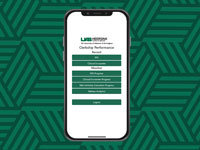 A new app rolling out this spring allows third-year medical students to track their progress throughout their clinical clerkship training.
A new app rolling out this spring allows third-year medical students to track their progress throughout their clinical clerkship training.
The clerkship app is a “one-stop shop” where medical students have access to track the required clinical encounters established for each of their clinical clerkships, along with evaluations required in each clerkship and progress on Entrustable Professional Activities (EPAs), providing a holistic view of their entire progress in clinical training.
“We wanted to give the students dashboards where they could look at their development of skills across all their clerkships and their entire clinical training,” said James Willig, M.D., MSPH, assistant dean for Clinical Education. “We wanted to be able to stress to students that what they learn in clinical training is about developing a well-rounded professional skill set across all clerkships.”
“My hope is that by having access to these data and being able to track their progress, students will be able to see more easily keep up with requirements for each Clerkship as well as seeing how they have grown throughout their third year of training.”
The app was developed in the UAB Heersink School of Medicine as a collaboration between Medical Education Information Services (Adam Agee and John Taylor, MBA), Cecil Robinson, PhD (director of Learning and Evaluation on the Tuscaloosa Campus), and Undergraduate Medical Education (Dr. Willig, Elizabeth Rahn, PhD, and Mike Belue,) in consultation with clerkship directors across the school and student leadership. The app has been live for approximately four weeks, and in its first two weeks more than 400 required encounters have been uploaded to date.
“Credit here absolutely begins with the clerkship directors, who met last fall and reformulated the required clinical encounters across all Clerkship specialties,” Willig said.
UAB medical students complete clerkships in internal medicine (8 weeks), surgery (8 weeks), obstetrics and gynecology (8 weeks), pediatrics (8 weeks), neurology (4 weeks), psychiatry (4 weeks) and family medicine (4 weeks) during their third year.
Each clerkship has required clinical encounters, or cases students must be exposed to as determined by Clerkship Directors in order to constitute a full experience in a specific discipline.
Willig explained that because clerkship directors cannot predict the exact patients who will seek treatment at a given time, there are alternate activities identified and provided to students to give them the knowledge they would gain from seeing patients in clinical settings. However, the Liaison Committee on Medical Education (LCME) dictates that alternates cannot substitute for more than 25 percent of the required clinical encounters in a clerkship.
“Clerkship directors also have access to dashboards with data about their specific clerkship, so they will be able to see where students are in completing their required encounters and how often students are having to use alternates,” Willig said, adding that the directors will review the data monthly at their meeting. He said specific clerkship data will be evaluated annually by leaders in medical education and will be a window into needed curricular adjustments.
“This new process allows us to better deliver on our educational objectives for each clerkship and to assess our effectiveness as a school of reaching those objectives,” he said. “These data are additional ways we can hold ourselves accountable for how we train our medical students and to see needed adjustments in their clinical training.”
Students and faculty are also able to log EPAs, which are 13 activities established by the Association of American Medical Colleges (AAMC) that all medical students should be able to perform upon entering residency, regardless of their future career specialty.
“In our clerkships, we hone in on three specific EPAs—taking a full patient history, performing a full patient exam and giving an oral presentation. Usually, those activities could take up to an hour of a student and faculty members’ time to complete fully, which is difficult to achieve in a high-volume patient environment,” Willig said.
“We’ve created mini-EPAs where these three larger competencies are broken down into smaller pieces that can be accomplished and evaluated in 7-10 minutes, giving students more opportunities for faculty feedback and making the components more manageable for faculty preceptors in high volume clinical environments.” These are also trackable in the clerkship app, which Willig said also gives students a high-level view of how their progressing and growing throughout their clinical training.
“My hope is that having more access to low-stakes feedback, students will be able to practice more, hone their skills further, and see their growth in what they’re learning from faculty in clinic and on the wards,” Willig said. “Being able to zoom out and see that progression over time is going to help them focus on being prepared to go to residency training and on being the best physician possible.”
